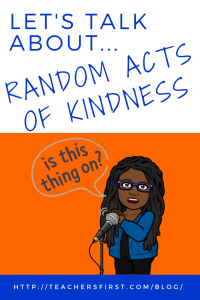Sustained social isolation during the pandemic has taken its toll on everyone, especially our students. As educators, we need to help our students with ways to meet social-emotional learning (SEL) needs while we collectively continue to work towards overcoming the COVID-19 pandemic threat. Science tells us that kindness increases your happiness, so now is the perfect time to be introducing the Random Acts of Kindness Week theme for this year – Make Kindness the Norm. While kindness benefits us individually, those who teach the United Nations Sustainable Development Goals will tell you that kindness is essential to reaching our global goals.
As teachers, there are many ways to infuse the concept of kindness into your instruction. I have captured just a few here:
- Kindness in the classroom is a K – 12 SEL curriculum broken into three grade bands; each unit covers the core concepts of respect, caring, inclusiveness, integrity, responsibility, and courage. The free lesson plans have been mapped to Common Core and ISTE standards and translated into many different languages.
- Caught being kind vouchers offered by twinkl (reviewed here) are an easy way to recognize kindness. A cute classroom mascot such as these kindness elves would do a great job delivering the voucher.
- This TEDx Kindness video playlist has over thirty videos that teachers can use to spark conversation about why kindness matters. Use one of the videos to create a TED-Ed lesson (reviewed here) and share it via your learning management system.
Some additional ideas for those at the elementary level include:
- You and your students can create an affirmation station like the ones seen on this blog post.
- Those who like crafts can create kindness rocks to leave for random community members. These rocks always bring a smile to my face when I see one while walking my dog on our local trail.
- There are many benefits for students who become silver readers. It’s great reading practice along, and then there are the thanks that are sure to be expressed by the recipient. Even if there isn’t a similar program in your community, there are elderly folks who would enjoy having a youngster read to them.
Middle School students can try these ideas in addition to those above:
- Students who make an inclusion pledge are poised to disrupt cycles of isolation that can be hard for middle schoolers. Pledging to value, respect, and embrace others who may not be typical friends is a way to contribute to a better, more inclusive society.
- Playing the Freerice game supports the United Nations’ World Food Programme. It is an easy way to send a financial donation without spending your own money. The program receives a gift worth five grains of rice for every advertisement displayed while you play.
- Hosting their own Positive Post-it Day can turn the tide at a school. It did for Caitlin Haacke and her entire community and rippled throughout the world.
High school students may want to add a bit more technology as they think about ways to be kind.
- They can work towards making kindness their norm by tracking random acts of kindness. You can encourage them to embark on kindness streaks using the KARMiC app for iOS or the BeKind app for Android. Each will help with suggestions for a kind deed every day and allow the user to track the number of days in a row they have completed.
- Like the silver readers, another suggestion with multiple benefits is using Charity Miles or WoofTrax for iOS or Android. Running, biking, or walking the dog increases physical fitness and releases powerful endorphins that increase personal positivity. Using one of the apps to track your exercise will trigger a donation to your charity of choice.
- For students who would like to have a touchpoint with the individual they are doing a random kindness for, there is the app Be My Eyes for iOS or Android. The app allows you to randomly help someone who is blind who needs momentary assistance from someone who can see.
Do you have additional ideas on how to help your students make kindness the norm? Please leave them in the comments below.



Thank you Dr. Ruth for recommending the BeKind app. We really appreciate it. We are hoping to help in spreading kindness through our app!
Such a thoughtful post! Random acts of kindness truly make a difference. Inspiring and beautifully written. Thank you!